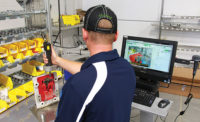Instructors at Fiat Chrysler Automobiles’ World Class Manufacturing Academy (WCMA) have one goal: get every student focused on world class manufacturing, which is Fiat’s version of Toyota’s lean manufacturing production system. To achieve their goal, instructors use teaching tools ranging from the latest assembly machines to children’s toys such as Lego building blocks.
Founded in 2011, the Warren, MI, academy combines classroom and hands-on instruction to facilitate sharing of WCM practices between Fiat Chrysler plants and employees. Thousands of workers have participated in academy classes, where they sharpen their assembly and logistics management skills. The workers then implement this knowledge at their respective plants to improve manufacturing processes.
A standard teaching tool at the academy is Light Guide Systems (LGS) software made by OPS Solutions LLC. Separate workstation installations of the software ensure error-free product assembly, and part kitting and sequencing during training. Fiat Chrysler learned about the software in 2011 from OPS Solutions president and LGS software inventor Paul Ryznar, who demonstrated it at Chrysler’s Toledo, OH, and Jefferson Avenue (Detroit) plants.
“Fiat Chrysler strives to deploy a visual management element in every operation and process, including paper-based standard work instructions (SWIs),” notes Ryznar. “However, flexible production lines that build multiple vehicles and options continually require more paper work instructions for assemblers. Our software makes workers more efficient and more valuable as the steps in manual assembly become increasingly complex and variable.”
LGS software features a customizable platform that allows engineers to input step-by-step instructions and project them onto the work surface. Built-in error-proofing mechanisms and a No Faults Forward system design ensure that the right parts are used, the approved sequence is followed, and the correct processes are completed safely, correctly and efficiently.
Fiat Chrysler especially likes the software’s audio and visual prompts, guidance, pacing and direction, all of which improve students’ workflow efficiency and accuracy. LGS generates detailed real-time build data (such as cycle time) and compares it against required standards and goals. This data also enhances traceability.
In August 2014, OPS Solutions and WCMA instructors performed a benchmarking study that compared the effectiveness of SWIs and LGS. This study involved 19 students performing both assembly and part kitting.
Ryznar says that when assemblers followed the software, they made 80 percent fewer errors. The software also reduced assembly cycle time by 38 percent, while increasing throughput by 82 percent.
As for part kitting and sequencing, the software reduced errors by 89 percent and cycle time by 48 percent. Ryznar says throughput increased 95 percent.
For more information on software that prevents assembly or kitting errors, call 248-374-8000 or visit www.ops-solutions.com.






